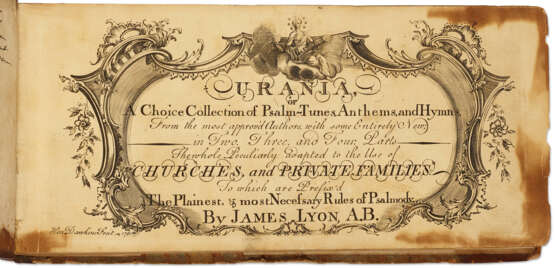ID 967357
Lot 163 | Urania
Estimate value
$ 15 000 – 25 000
America’s earliest anthems.
Extremely rare complete first edition of the first printed book of American songs with music. This is the only complete copy recorded in the auction records of RBH since 1903. It contains the first American printing of the tune for “My Country 'Tis of Thee.” James Lyon was one of a very few composers in mid-18th century America. “He attended the college of New Jersey (later Princeton) and was mentioned as the composer of the music for the class ode, presented at the graduation exercises in 1759. In May 1760 he was in Philadelphia taking subscriptions for a projected collection of hymn tunes [the present work]” (DAB). This commencement ode is a strong contender for the first secular song composed by a named American. Lyon's avowed purpose with Urania, which must have been formed while he was still in college, was to make: “the first Attempt of the kind to spread the Art of Psalmody, in its Perfection, thro’ our American Colonies” (Pennsylvania Journal, 22 May 1760).
Lyons's Urania is not the first hymnal printed in the Colonies, but it is the first pointedly American effort—collected by a New Jersey-born American for the express purpose of improving the music in colonial Church services. Lyon is the presumed author also of an anonymous 1763 tract urging Presbyterians to relax their hostility to instrumental music (DAB). The tune which eventually became "America (My Country 'Tis of Thee)" (when paired with the lyrics of Samuel Smith in 1831), is printed here on p.190 ff with religious lyrics.
Henry Dawkins engraved the contents of this work. Born in England, he was among the very first copper-plate engravers to operate in the Colonies, setting up shop around 1754. During the Revolution, James Lyon was an ardent and active patriot—even making a detailed proposal to George Washington for the conquest of Nova Scotia. Dawkins, on the other hand, although not a Loyalist, was arrested and probably hanged in 1776 for counterfeiting Continental currency.
This volume would have been extremely expensive to produce and it was sold for 15 shillings. However, it was popular enough to go into both second and third editions in Lyon’s lifetime. All 18th century editions are extremely rare; but this complete first edition is practically unique. It conforms to all first printing points as described by Richard Crawford, and has five pages with the asterisk which denotes new compositions (pages 44, 50, 63, 125, and 165). Evans 8908; Sabin 42856. See also Crawford, Richard. "Preface [with Appendices,]" Urania. New York, 1974; Sonneck, O.G. Francis Hopkinson & James Lyon: Two Studies in Early American Music, Washington, DC, 1905; and Temperley, Nicholas. "First Forty: The Earliest American Compositions," in American Music, Vol. 15, No. 1 (Spring, 1997).
Oblong 12mo (112 x 240mm). Engraved title page by Henry Dawkins (browning to outer edge, splitting at plate mark), letterpress dedication, index and subscriber's list; 105 engraved musical leaves printed recto and verso. Early 19th-century American sheep over marbled paper boards (front joint cracked, lacking free endpapers, edges worn). Custom quarter morocco slipcase. Provenance: Fred F. Lathrop, choir leader of Bridgeport, CT, born 1818 (according to note on inside front cover) – Olive Gulis (ownership inscription) – Bonhams New York, 17 June 2021, lot 56.
| Artist: | James Lyon (1735 - 1794) |
|---|---|
| Place of origin: | USA |
| Auction house category: | Printed books |
| Artist: | James Lyon (1735 - 1794) |
|---|---|
| Place of origin: | USA |
| Auction house category: | Printed books |
| Address of auction |
CHRISTIE'S 20 Rockefeller Plaza 10020 New York USA | ||||||||||||||
|---|---|---|---|---|---|---|---|---|---|---|---|---|---|---|---|
| Preview |
| ||||||||||||||
| Phone | +1 212 636 2000 | ||||||||||||||
| Fax | +1 212 636 4930 | ||||||||||||||
| Conditions of purchase | Conditions of purchase | ||||||||||||||
| Shipping |
Postal service Courier service pickup by yourself | ||||||||||||||
| Payment methods |
Wire Transfer | ||||||||||||||
| Business hours | Business hours
|





